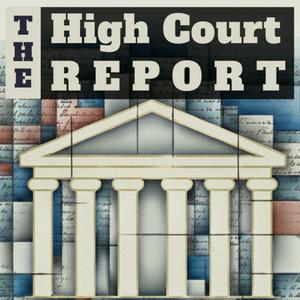Available Episodes
5 of 382
- Oral Argument: FS Credit v. Saba | Fund Feud: Forcing Fiduciary Fairness Through Federal LawsuitsFS Credit v. Saba | Fund Feud: Forcing Fiduciary Fairness Through Federal Lawsuits | Argument Date: 12/10/25 | Docket Link: HereQuestion Presented: Whether Section 47(b) of the Investment Company Act of 1940 gives private plaintiffs a federal cause of action to seek rescission of contracts that allegedly violate the Act.OverviewThe Supreme Court will decide whether activist investors can sue investment funds directly in federal court when funds adopt governance provisions that allegedly violate federal securities law. Four closed-end funds adopted Maryland Control Share Acquisition Act provisions to strip voting rights from shareholders acquiring more than 10% ownership, prompting Saba Capital to seek rescission under Section 47(b) of the Investment Company Act. The case creates a fundamental clash over private enforcement of securities laws versus exclusive SEC regulatory authority, with implications for millions of Americans who invest in mutual funds and closed-end funds.Question Presented:Oral Advocates:For Petitioner (FS Credit) and Respondents (BlackRock): Shay Dvoretzky, Washington, D.C. United States as Amicus Curiae in Support of Petitioners: Max E. Schulman, Assistant to the Solicitor General, Department of JusticeFor Respondent: Paul D. Clement, Alexandria, VALink to Opinion: TBD.Website Link to Opinion Summary: TBD. Website Link to Oral Argument: TBD. Timestamps: [00:00:00] Oral Argument Preview[00:01:23] Oral Argument Begins[00:01:36] Petitioner Opening Statement[00:03:40] Petitioner Free for All Questions[00:19:29] Petitioner Round Robin Questions[00:30:53] United States as Amicus Curiae Opening Statement[00:32:17] United States Free for All Questions[00:42:11] United States Round Robin Questions[00:46:27] Respondent Opening Statement[00:48:55] Respondent Free for All Questions[01:16:48] Respondent Round Robin Questions[01:16:58] Petitioner Rebuttal--------1:20:19
- Oral Argument: Hamm v. Smith | IQ Score ShowdownHamm v. Smith | Case No. 24-872 | Oral Argument Date: 12/10/25 | Docket Link: HereQuestion Presented: When someone takes multiple IQ tests to prove intellectual disability in a capital case, do courts look at all the scores together, or can one low score alone save their life?OverviewThe Supreme Court will decide whether courts must evaluate multiple IQ scores collectively or whether a single qualifying score triggers constitutional protection in death penalty cases. This decision affects hundreds of current death row inmates and reshapes capital litigation nationwide.Oral Advocates:For Petitioner (Hamm): Robert M. Overing, Principal Deputy Solicitor General, Montgomery, Alabama argued for Petitioner Hamm. United States as Amicus Curaie in Support of Petitioner: Harry Graver, Assistant to the Solicitor General, Department of Justice. For Respondent (Smith): Seth P. Waxman, Washington, D.C.Link to Opinion: TBD.Website Link to Opinion Summary: TBD. Website Link to Oral Argument: TBD. Timestamps: [00:00:00] Oral Argument Preview[00:01:28] Oral Argument Begins[00:01:43] Petitioner Opening Statement[00:03:58] Petitioner Free for All Questions[00:20:43] Petitioner Round Robin Questions[00:44:36] United States as Amicus Curiae Opening Statement[00:45:47] United States Free for All Questions[00:55:27] United States Round Robin Questions[01:21:13] Respondent Opening Statement[01:24:00] Respondent Free for All Questions[01:51:28] Respondent Round Robin Questions[02:01:18] Petitioner Rebuttal--------2:03:10
- Six Pack of Takeaways + Prediction: Trump v. SlaughterSummary:Analysis of the December 8, 2025 Supreme Court oral arguments in Trump v. Slaughter, examining how the justices signaled their likely approach to presidential removal power and independent agencies.Key Topics Covered:1. Chief Justice Roberts' Strategic QuestioningFocused on workability and implementation detailsChallenged quality of precedents supporting Slaughter's positionUnusual volume of questions suggests engagement with Trump's arguments2. Justice Sotomayor's Stare Decisis DefenseMounted strongest defense of Humphrey's Executor (1935)Emphasized 90-year precedential historyQuestioned Court's willingness to overturn longstanding constitutional precedent3. Predicted 6-3 Ruling for TrumpCourt's emergency docket orders already revealed likely outcomeThree-step analysis: presidential removal power + FTC executive authority + distinguish/overrule Humphrey's4. Competing Predictions About ImpactSlaughter's team: regulatory chaos, undermined business planningTrump's team: "sky did not fall" in previous agency restructurings5. The "Faithful Execution" ThreadJustice Gorsuch's devastating questioning about Take Care ClauseExposed contradiction in Slaughter's constitutional theory"Ruinous fines" vs. misdemeanor enforcement distinction crumbles6. The Defense Department ProblemCongress could restructure Cabinet departments as protected commissionsSlaughter's logic threatens executive unity across governmentNo limiting principle to prevent wholesale agency insulationBonus: Trump v. United States Framework"Conclusive and preclusive" authority test from immunity caseBoth sides weaponized language for removal power debateConstitutional framework that shaped entire argumentNext Episode: Analysis of post-argument developments and decision timeline--------8:19
- Oral Argument: NRSC v. FEC | Camaign Finance First Amendment FightNRSC v. FEC | Money, Messaging, and Muzzling: The First Amendment Fight Over Party Coordination | Argument Date: 12/9/15 | Docket Link: HereQuestion Presented: Whether the First Amendment permits limits on the amount of money that the national committee of a political party may contribute to political candidates in the form of coordinated expenditures.OverviewThis oral argument involves National Republican Senatorial Committee versus Federal Election Commission, a landmark campaign finance case that could fundamentally reshape how political parties operate in federal elections, featuring the extraordinary situation where the Federal Election Commission itself now agrees with the challengers that coordinated party expenditure limits violate the First Amendment. The case centers on limits that cap how much money party committees can spend in coordination with their candidates, creating a constitutional clash over political speech rights and anti-corruption measures. With the government switching sides post-election, the Court appointed an outside lawyer to defend the law while Democratic Party committees intervened to provide the opposition the case desperately needed.Oral Advocates:For Petitioner (NRSC): Noel J. Francisco, Washington, D.C., argued for Petitioners NRSC. For Respondents in Support of Petitioners (FEC): Sarah M. Harris, Principal Deputy Solicitor General, Department of Justice, argued in support of NRSC. Court-Appointed Amicus Curiae in Support of the Judgment Below: Roman Martinez, Washington, D.C. For Intervenor (DNC): Marc E. Elias, Washington, D.C.Link to Opinion: TBD.Website Link to Opinion Summary: TBD. Website Link to Oral Argument: TBD. Timestamps: [00:00:00] Oral Argument Preview[00:02:28] Oral Argument Begins[00:02:38] Petitioner Opening Statement[00:04:39] Petitioner Free for All Questions[00:18:19] Petitioner Round Robin Questions[00:48:54] United States in Support of Petitioner Opening Statement[00:50:08] United States Free for All Questions[01:05:22] United States Round Robin Questions[01:19:53] Court Appointed Amicus Curiae Opening Statement[01:22:17] Court Appointed Amicus Curiae Free for All Questions[01:38:08] Court Appointed Amicus Curiae Round Robin Questions[01:44:55] DNC As Intervenors Opening Statement[01:46:17] DNC As Intervenors Free for All Questions[02:00:05] DNC As Intervenor Round Robin Questions[02:09:51] Petitioner Rebuttal--------2:13:14
- Oral Argument: Trump v. Slaughter | Presidential Power PlayTrump v. Slaughter | Presidential Power Play : Trump's Total Takedown of Independent Agencies | Case No. 25-332 | Oral Argument Date: 12/8/25 | Docket Link: HereQuestion Presented: Whether Congress can require the President to show cause before removing commissioners of independent agencies, or whether Article II grants the President absolute removal power over all executive officers.OverviewPresident Trump removed FTC Commissioner Rebecca Slaughter without cause, challenging the constitutional foundation of independent agencies. The Court confronts whether two dozen independent agencies that control $47 trillion in economic activity can maintain protection from at-will presidential removal.Oral Advocates:For Petitioner (Trump): D. John Sauer, Solicitor General, Department of Justice. For Respondent (Slaughter): Amit Agarwal, Washington, D.C.Link to Opinion: TBD.Website Link to Opinion Summary: TBD. Website Link to Oral Argument: TBD. Timestamps: [00:00:00] Oral Argument Preview[00:02:03] Oral Argument Begins[00:02:11] Petitioner Opening Statement[00:04:06] Petitioner Free for All Questions[00:27:29] Petitioner Round Robin Questions[01:05:33] Respondent Opening Statement[01:08:00] Respondent Free for All Questions[01:37:09] Petitioner Round Robin Questions[02:29:03] Petitioner Rebuttal--------2:32:33
More Business podcasts
Trending Business podcasts
About The High Court Report
The High Court Report makes Supreme Court decisions accessible to everyone.
We deliver comprehensive SCOTUS coverage without the legal jargon or partisan spin—just clear analysis that explains how these cases affect your life, business, and community.
What you get: Case previews and breakdowns, raw oral argument audio, curated key exchanges, detailed opinion analysis, and expert commentary from a practicing attorney who's spent 12 years in courtrooms arguing the same types of cases the Supreme Court hears.
Why it works: Whether you need a focused 10-minute update or a deep constitutional dive, episodes are designed for busy professionals, engaged citizens, and anyone who wants to understand how the Court shapes America.
When we publish: 3-5 episodes weekly during the Court's October-June term, with summer coverage of emergency orders and retrospective analysis.
Growing archive: Oral arguments back to 2020 and expanding, so you can hear how landmark cases unfolded and track the Court's evolution.
Your direct line to understanding the Supreme Court—accessible, thorough, and grounded in real legal expertise.**
Podcast websiteListen to The High Court Report, FEAR & GREED | Business News and many other podcasts from around the world with the radio.net app

Get the free radio.net app
- Stations and podcasts to bookmark
- Stream via Wi-Fi or Bluetooth
- Supports Carplay & Android Auto
- Many other app features
Get the free radio.net app
- Stations and podcasts to bookmark
- Stream via Wi-Fi or Bluetooth
- Supports Carplay & Android Auto
- Many other app features


The High Court Report
Scan code,
download the app,
start listening.
download the app,
start listening.































